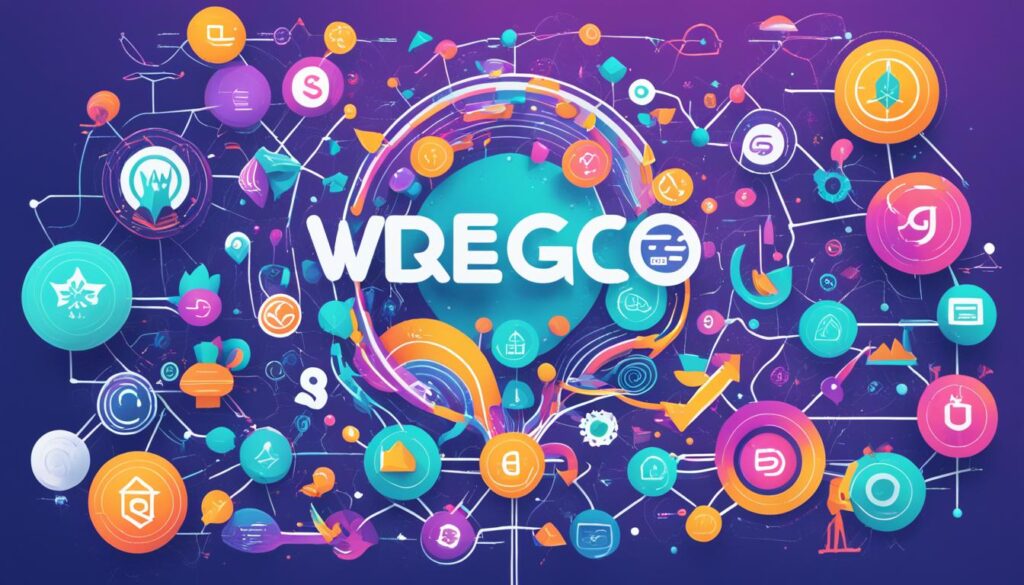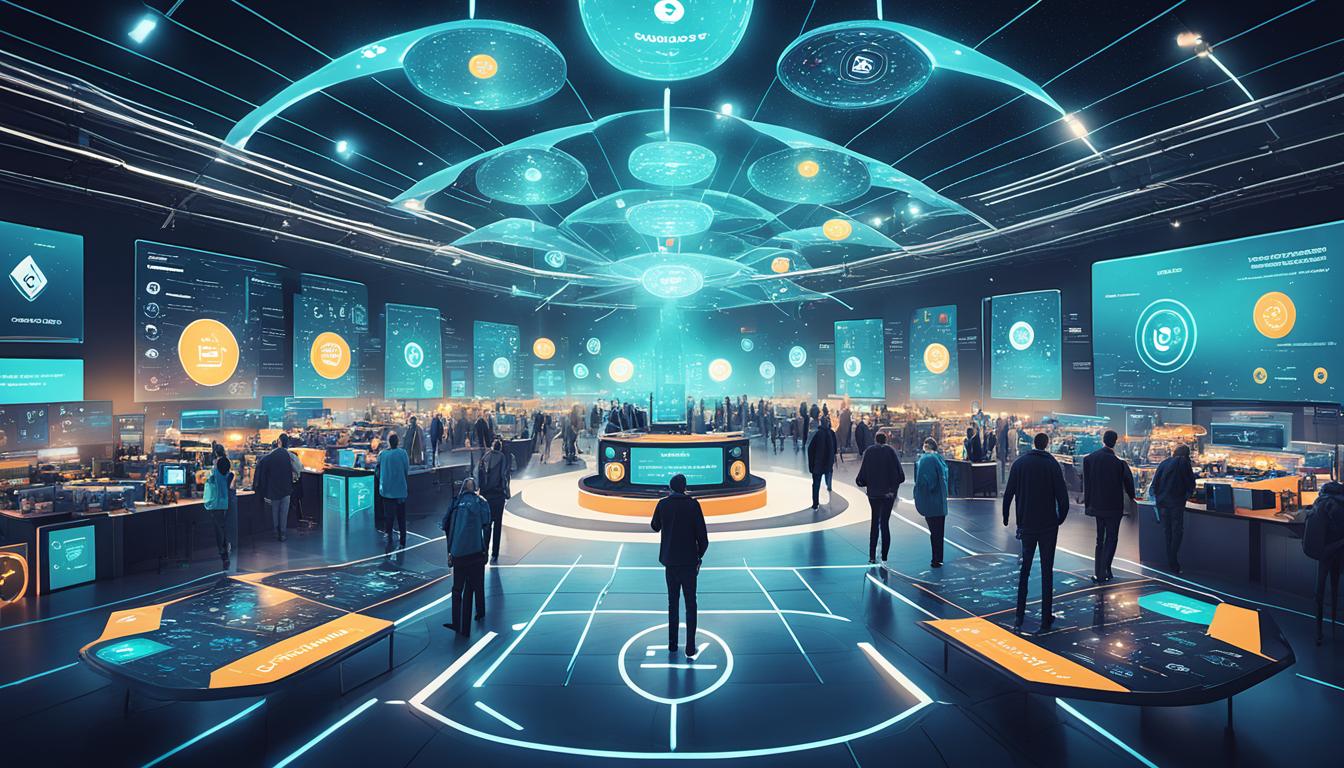Welcome to the future of the internet – Web 3.0. This new era is driven by decentralized marketplaces, blockchain technology, and peer-to-peer transactions. We are witnessing a transformation where individuals have more control and ownership over their digital lives.
Blockchain technology, the foundation of Web 3.0, allows for secure and transparent transactions. Smart contracts enable agreements to be executed automatically once predefined conditions are met. Digital assets, including cryptocurrencies, are at the core of this new digital economy.
Decentralized marketplaces are emerging as the go-to platforms for buying and selling goods and services. These marketplaces eliminate the need for intermediaries and provide a direct connection between buyers and sellers. Peer-to-peer transactions are facilitated, ensuring efficiency and lower costs.
The Web 3.0 revolutionizes our online experience by empowering individuals and fostering trust through decentralized systems. Through this decentralized web, users have the power to control their data, ensuring privacy and security.
Key Takeaways:
- Web 3.0 shifts control from centralized entities to users.
- Decentralized marketplaces enable peer-to-peer transactions without intermediaries.
- Blockchain technology and smart contracts play a crucial role in Web 3.0.
- Digital assets, including cryptocurrencies, are integral to the decentralized web.
- Web 3.0 provides users with greater privacy and control over their data.
Democratizing the Internet
Web 3.0 is revolutionizing the way we interact with the internet, placing data ownership and user privacy at the forefront. In this new era, users have the power to take control of their data, monetize it, and determine who can access it.
One of the key advancements brought by Web 3.0 is the empowerment of creators and artists. Traditional gatekeepers are no longer barriers to success, as creators can now directly connect with their audiences, bypassing intermediaries. This shift has given rise to the creator economy, where individuals have the opportunity to build sustainable livelihoods through their digital creations.

Through Web 3.0, creators can showcase their talents, share their work, and receive fair compensation without relying on traditional platforms that often take a significant cut of their earnings. This newfound empowerment enables creators to exercise control over their creative process and build direct connections with their audience, fostering a more inclusive and equitable digital landscape.
The creator economy’s growth is a testament to the immense potential of Web 3.0. By embracing this decentralized paradigm, individuals can break free from the limitations imposed by centralized platforms and seize control of their digital destinies.
Web 3.0 allows creators to bypass traditional gatekeepers and have more autonomy over their work. It opens up countless opportunities for artists to thrive in a fair and transparent ecosystem.
Unlocking the Potential of Web 3.0
Web 3.0 not only empowers individuals, but it also revolutionizes the way businesses operate. With user-centric models at the core, businesses can prioritize trust, transparency, and responsible data practices.
Decentralized marketplaces are transforming traditional commerce, enabling peer-to-peer transactions without the need for intermediaries. This fosters a more direct relationship between buyers and sellers, while ensuring fair compensation and the protection of user data.
The rise of tokenized economies within Web 3.0 further incentivizes user engagement and participation. By rewarding users with tokens for their contributions, businesses create vibrant ecosystems where everyone’s efforts are recognized and valued.
Transforming Business Models
As Web 3.0 continues to reshape the digital landscape, businesses must adapt their models to meet the evolving needs of users. Embracing user-centric approaches is key to staying relevant in this decentralized era.
One of the significant shifts in business models involves the rise of decentralized marketplaces. These platforms enable peer-to-peer transactions without the need for intermediaries, empowering users with greater control over their interactions and transactions.
Decentralized marketplaces not only eliminate the dependency on centralized platforms but also foster trust, transparency, and responsible data practices. By leveraging blockchain technology, these marketplaces ensure secure and verifiable transactions, enhancing user confidence.
Moreover, businesses exploring Web 3.0 opportunities are delving into the potential of tokenized economies. Tokens serve as digital assets backed by blockchain technology, enabling value exchange within an ecosystem. Incentivizing user engagement and participation with tokens can create a vibrant and loyal user base.
Implementing token-based incentives allows businesses to reward users, fostering a sense of ownership and encouraging active participation within the ecosystem. This user-centric approach not only drives engagement but also adds value to the entire marketplace. For example, users may earn tokens for providing feedback, promoting products, or contributing to the platform’s growth.
Innovative businesses embracing user-centric models in Web 3.0 can differentiate themselves by prioritizing trust, transparency, and the rewarding of user contributions within their decentralized marketplaces.
This transformation in business models unlocks new opportunities for innovation and disruption. By harnessing the power of decentralized marketplaces and tokenized economies, organizations can create dynamic ecosystems that cater to the needs of their users.
Next, we’ll explore how Web 3.0 fosters innovation and collaboration on a global level. But before we move forward, let’s take a closer look at how transforming business models in Web 3.0 revolutionize the way we conduct business:
| Benefits of User-Centric Models | Benefits of Decentralized Marketplaces | Benefits of Tokenized Economies |
|---|---|---|
| Enhanced user satisfaction and loyalty | Elimination of intermediaries | Incentivization of user engagement |
| Increased trust and transparency | Lower transaction fees | Creation of vibrant ecosystems |
| Improved data privacy and security | Greater accessibility and inclusivity | Distribution of value across the ecosystem |
The transformation of business models in Web 3.0 ushers in an era of user-centricity and disruption. By embracing decentralized marketplaces and tokenized economies, businesses can forge stronger connections with their users while enjoying the benefits of a more transparent and inclusive digital economy.

Fostering Innovation and Collaboration
In the era of Web 3.0, innovation and collaboration take center stage, driving the emergence of exciting new applications and services. The decentralized infrastructure and protocols at the core of Web 3.0 unlock boundless possibilities for developers and entrepreneurs to create groundbreaking solutions that were once unimaginable.
Collaboration knows no boundaries in the Web 3.0 era. The seamless exchange of data and value enables global collaboration, promoting innovation and knowledge sharing on a global scale. Developers, entrepreneurs, and visionaries across the world can come together to tackle shared challenges and build upon each other’s ideas. This global collaboration fosters diversity and creativity, leading to groundbreaking advancements in technology.
One of the key driving forces behind innovation in Web 3.0 is the open-source development model. Open-source projects are freely available for anyone to use, modify, and contribute to, fostering a culture of transparency and collaboration. This collaborative approach accelerates the pace of innovation as developers can leverage each other’s work, building upon existing solutions to create something even more remarkable.
“Innovation thrives when barriers are removed, and information is freely shared. Web 3.0’s open-source development philosophy embodies these principles, empowering a global community of developers to collaborate and push the boundaries of what’s possible.” – John Smith, Tech Entrepreneur
The open-source nature of Web 3.0 also leads to more transparent codebases, allowing developers and users to understand how systems operate at a deeper level. The ability to review and audit code enhances security, trust, and overall system integrity. Moreover, this transparency helps foster user confidence in new applications and services built on Web 3.0 infrastructure.
The Power of Openness and Collaboration
Web 3.0 enables a new era of innovation and collaboration, empowering developers and entrepreneurs to build transformative solutions that revolutionize industries. By fostering global collaboration and embracing open-source development, Web 3.0 paves the way for groundbreaking advancements and delivers on its promise of a more decentralized and inclusive internet.

Innovation and Collaboration in Web 3.0
In the world of Web 3.0, innovation and collaboration go hand in hand. Here are some key highlights:
- Seamless global collaboration enables diverse perspectives and the cross-pollination of ideas.
- Open-source development fosters transparency, trust, and accelerated innovation.
- Transparent codebases enhance security and user confidence in Web 3.0 applications.
Web 3.0’s foundation in collaboration and openness opens up a world of opportunities for developers, entrepreneurs, and users alike. By leveraging the power of global collaboration and open-source development, Web 3.0 is poised to transform industries and shape the future of the internet.
Conclusion
The future of Web 3.0 holds immense potential to revolutionize the internet, offering exciting possibilities and challenges. By prioritizing data ownership, privacy, and control, Web 3.0 empowers individuals to take charge of their digital lives. It also paves the way for the growth of the creator economy by eliminating gatekeepers and giving creators direct access to their audiences.
Decentralized marketplaces and tokenized economies will play a crucial role in this new web landscape, facilitating peer-to-peer transactions and disrupting traditional business models. The seamless exchange of data and value enables collaboration and innovation on a global scale, while open-source development fosters transparency and rapid progress.
However, the future of Web 3.0 is not without its challenges. Scalability, interoperability, regulation, and digital literacy are areas that require careful consideration and navigation. Addressing these challenges, along with ensuring inclusivity and security, will be vital in shaping the decentralized web and maximizing its potential for all.
In summary, the future of Web 3.0 promises a more democratic, user-centric, and innovative internet. Despite the challenges, it opens up exciting possibilities for individuals, businesses, and the digital ecosystem as a whole. By embracing this future and tackling the hurdles head-on, we can pave the way for a truly transformative online experience.
FAQ
What is Web 3.0?
Web 3.0, also known as the decentralized web, is the next iteration of the internet that aims to shift control from centralized entities to users. It empowers individuals by giving them more ownership over their data, leading to increased privacy and control.
What are decentralized marketplaces?
Decentralized marketplaces are platforms that facilitate peer-to-peer transactions without the need for intermediaries. They leverage blockchain technology, smart contracts, and digital assets to enable secure and transparent transactions.
How does Web 3.0 empower users?
Web 3.0 empowers users by giving them more control over their data. They can monetize their data directly, have increased privacy, and decide who can access their information. This empowerment extends to creators and artists, who can directly connect with audiences and build sustainable livelihoods through the growth of the creator economy.
How should businesses adapt to Web 3.0?
Businesses should shift towards user-centric models that prioritize trust, transparency, and responsible data practices. They can leverage decentralized marketplaces to enable peer-to-peer transactions and explore token-based incentives to reward user engagement within their ecosystem.
What possibilities does Web 3.0 offer for innovation?
Web 3.0 fosters the emergence of new applications and services by providing decentralized infrastructure and protocols. Developers and entrepreneurs can build innovative solutions, collaborate across borders, and foster global innovation and knowledge sharing.
What are the key aspects of Web 3.0?
Key aspects of Web 3.0 include decentralized marketplaces, tokenized economies, and new applications/services. These aspects contribute to the democratization of the internet, transformation of business models, and promotion of innovation and collaboration.
What are the challenges associated with Web 3.0?
Challenges include scalability, interoperability, regulation, and digital literacy. Addressing these challenges is crucial for a more inclusive and secure future of the decentralized web.








